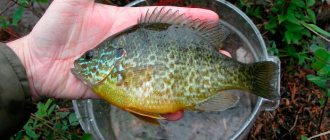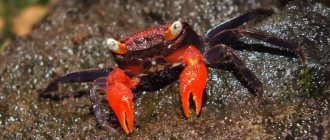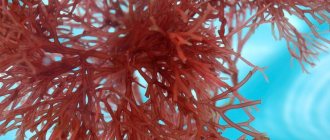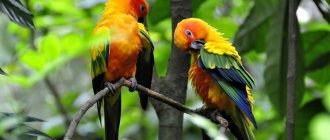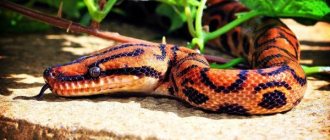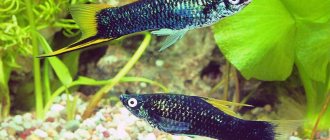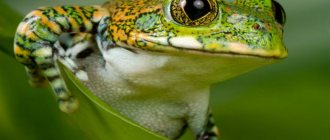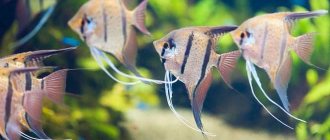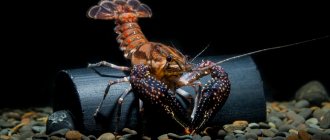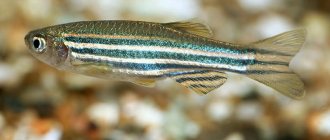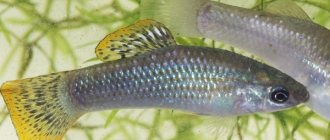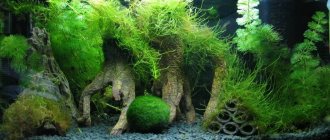North America is considered to be the homeland of the sunfish; it was from there that this rainbow fish was first imported. At the very beginning, it was used exclusively for decorative purposes; it decorated fountains and artificial ponds in the estates of the nobility. And later she came to the Danube, where she lives to this day. For its special endurance and unique appearance, it is also loved by aquarists.
This type of fish is great for decorative purposes.
Description of eared perches
Sunfish are small in size - about 10-30 centimeters. The body of eared perches is flattened on the sides, the body shape is oval, high.
There are at least 3 spiny rays on the anal fin; in addition, there may be 5-13 rays on the single dorsal fin, but most often their number is 10-12.
Eared Perch (Centrarchus macropterus).
On the upper part of the gill cover there is a bright elongated spot resembling an ear, thanks to which the perches were called “eared”. The brightest color is characteristic of young individuals; with age, the color of sunfish becomes paler.
Winter fishing
Fishing in winter has a number of features that must be taken into account:
- Sharp bites in winter require frequent hooking of baits.
- The bait should attract fish by smell, taste, and game.
- The bait should be held well on the hook.
- In winter, perch is so careful that its bites are difficult to notice even for experienced fishermen.
- It is recommended to shade the hole, which makes it possible to observe what is happening under the ice layer. Transparent water will allow you to see how the perch swallows the bait. At decent depths or muddy water, using brightly colored bait will help you observe the bite.
- Since it is difficult to follow the movement of the float when fishing for “Americans,” experienced fishermen use a flashlight. If the light source is raised high, then even at low power the hole will be well illuminated. The shimmer of light and shine of the equipment will attract fish.
Genus Lepomys
There are 16 known species of sunfish in the genus Lepomys. As noted, many perches are 10-30 centimeters in size, but there are also larger specimens that reach a length of 40 centimeters. In all species, the so-called ear is well defined on the gill cover.
These fish are unpretentious in keeping, but they have a cocky character, so they do not get along well with other inhabitants of the aquarium.
This species of sunfish is well known to aquarists.
Habitat in nature
There are 30-35 freshwater species of sunfish (family Centrarchidae) in the world, found in Canada, the United States and Central America.
The sunfish's natural range in North America extends from New Brunswick down the East Coast to South Carolina. It then travels inland to the middle of North America and extends through Iowa and back through Pennsylvania.
They are found primarily in the northeastern United States and less commonly in the south-central or southwestern regions of the continent. However, the fish was introduced to most of North America. They can now be found from Washington and Oregon on the Pacific coast to Georgia on the Atlantic coast.
In Europe it is considered an invasive species because, when exposed to suitable conditions, it quickly displaces native fish species. Populations have been recorded in Hungary, Russia, Switzerland, Morocco, Guatemala and other countries.
They usually live in warm, calm lakes, ponds and streams, small rivers with plenty of vegetation. They prefer clean water and places where they can find shelter. They stay close to the shore and can be found in large numbers on shallow reaches. They feed at all water levels from surface to bottom, most intensely during the day.
Sunfish typically live in schools, which may also include other related species.
Groups of young fish stay close to shore, but adults tend to move in groups of two to four into deeper water. Perch are active throughout the day, but rest at night near the bottom or in protected areas near snags.
Species of sunny blue perch
This representative boasts a whole palette of colors: yellow, brown, orange, blue, olive and red. All these colors unusually shimmer in the form of stripes and spots. But in the second year of life, these perches turn bright blue, which is why they got their name.
The blue coloration of the perch appears only in the second year of life.
Fishing object
Sunfish tend to bite on worms and are easy to catch while fishing. Many anglers consider it a trash fish because it bites easily and often when the fisherman is trying to catch something else.
Because bass stay in shallow water and feed all day, the fish are relatively easy to catch from shore. They will bite even the largest bait - including garden worms, insects, leeches or pieces of fish.
But, sunfish are very popular with young fishermen because of their willingness to bite, their abundance and their proximity to shore.
Although people think the fish tastes good, it is not popular due to its small size. Its meat is low in fat and high in protein.
Species common sunflower or false kinglet
The body of the common sunflower is covered with transverse uneven burgundy-brown stripes, and the general background is greenish-yellow. There is a bright orange spot on the back. These small fish are merciless predators; they ambush their victims.
False kings are called bloodthirsty lepomis for their bandit morals.
Reproduction
The male fiercely guards his nest from other males.
Drives all other fish away from him, including females. If the aquarium is not too large and the nests of several males are close to each other, then fights often occur. After constructing the nest, the male begins to push the female towards it. He circles her, gets close, and then they circle together. At this time, eggs are laid. The female then swims away, and he continues to guard his nest like a watchman.
The spawning process is interesting when there is one female and several males. All males build nests, but spawning occurs only in the nest of the strongest. Just like the Turkish Sultan...
After spawning, he takes care of the eggs. With strong movements of its fins, it increases the movement of water in the area where the eggs are located, thus clearing the nest of impurities and unfertilized eggs. Hatching of the larvae occurs after 2-3 days at water temperatures up to 24°.
The fry should be fed live dust. Young Sun Perches eat a lot. But they grow slowly and unevenly. Therefore, from the age of two months, it is better to sort them into groups by size. The fry begin to show the color of adult fish as early as three months.
Genus centrarchus
There is only one species in the sunfish genus Centrarchus, called the longfin perch or peacock's eye. The length of a peacock's eye reaches 15 centimeters. The body is grayish translucent, with a dark spot on each scale. There are also shiny and dark spots on the fins, and on the back there is an orange spot with a black edging.
Long-finned perches are quite peaceful in nature.
Fishing Features
The mouth cavity of the fish is small, which does not prevent the perch from swallowing fry of other species. Considering this feature, when fishing it makes sense to use large fishing hooks No. 10. Of all the baits, perch gives preference to maggots, although it will not refuse crawlings or earthworms.
It is possible to catch an “American ” using a spinning rod. If the fish is passive and does not pay attention to the spoon, then a jig rig helps out. This fishing method is suitable for both open water and ice fishing.
The spawning period is the best time for fishing for sunfish; it is clearly visible in shallow water. At other times, the fish prefers deeper places, it is more difficult to find it and you cannot do without bait. Feeder bloodworms are thrown along the edge of the shoreline, which attracts a considerable number of fish. The bite usually begins immediately after the bait hits the water.
Elassoma genus
From Greek, the name of the genus is translated as “small body,” which indicates the tiny size of these perches - their length does not exceed 3-4 centimeters. There are 6 species among dwarf sunfish. Their body is elongated, flattened on the sides, and their fins are fan-shaped.
They are found in the southern United States in swamps and small ponds. Among aquarists, perches of the genus Elassoma are popular due to their rainbow colors.
All sunfish are quite unpretentious in their maintenance, and their beauty can transform any aquarium.
If you find an error, please select a piece of text and press Ctrl+Enter.
Feeding
In nature, they feed on a variety of small foods both on the surface of the water and on the bottom. Among their favorites: insects, mosquito larvae, small molluscs and crustaceans, worms, fry and even other small perches.
They are known to feed on small crayfish and sometimes small pieces of vegetation, as well as small frogs or tadpoles.
Sunfish that live in waters with larger gastropods have larger mouths and associated muscles for breaking the shells of larger gastropods
In the aquarium they are also carnivorous and prefer to eat insects, worms and small fish.
Americans write that newly caught individuals may refuse unfamiliar foods, but over time they can be trained to eat fresh shrimp, frozen bloodworms, krill, cichlid pellets, cereal and other similar products.
Reproduction and offspring
River perch becomes sexually mature only after reaching two or three years of age, and such aquatic predators move to spawning sites, gathering in fairly large schools. The spawning process occurs in shallow river waters or in fresh water bodies with weak currents. The water temperature should be within 7-15°C.
The eggs fertilized by males are attached to various underwater snags, the surface of submerged branches or the root system of coastal vegetation. As a rule, a clutch of eggs resembles a kind of lace ribbon up to a meter long, consisting of 700-800 thousand not too large eggs.
River perch fry are born after about three to four weeks. During the first months of life, coastal plankton is used as food, and when they reach a size of 10 cm, they become typical predators. Any marine subspecies belongs to the category of viviparous, and the female of such a perch during the mating season is capable of sweeping about two million fry, which rise to the surface and feed in the same way as juvenile freshwater perches.
Natural enemies
Natural enemies of river perch are fairly large aquatic inhabitants, represented by pike, catfish, pike perch, salmon, burbot and eel.
Perch is often hunted by loons, osprey, gulls and terns. Perch is one of the very popular objects of domestic and foreign recreational fishing, so the main enemy of such an aquatic predator is still humans.
Cannibalism is characteristic of perches, which is especially common in the autumn, but in some natural reservoirs inhabited only by such a river predator, the process of cannibalism is the norm of life.
